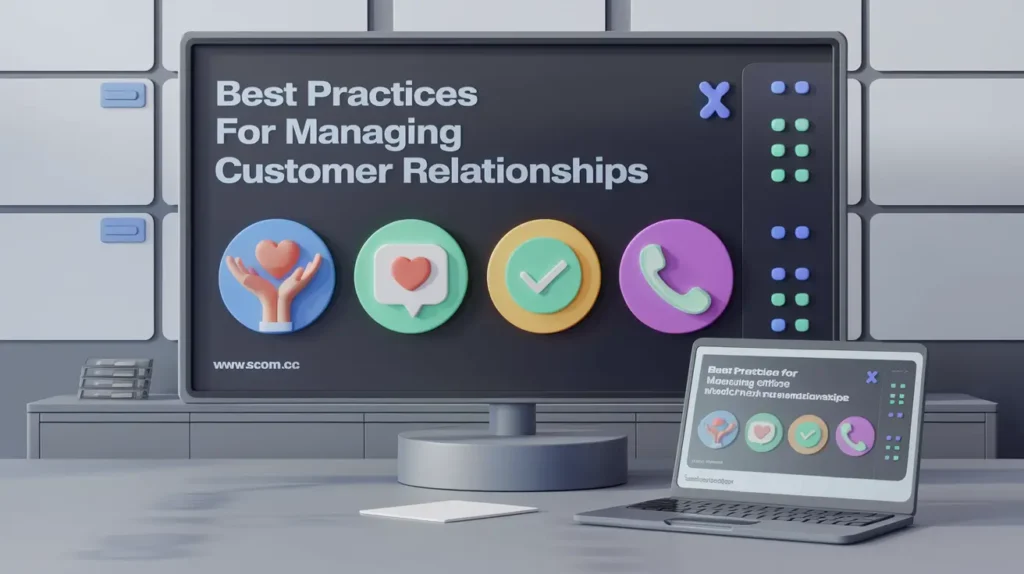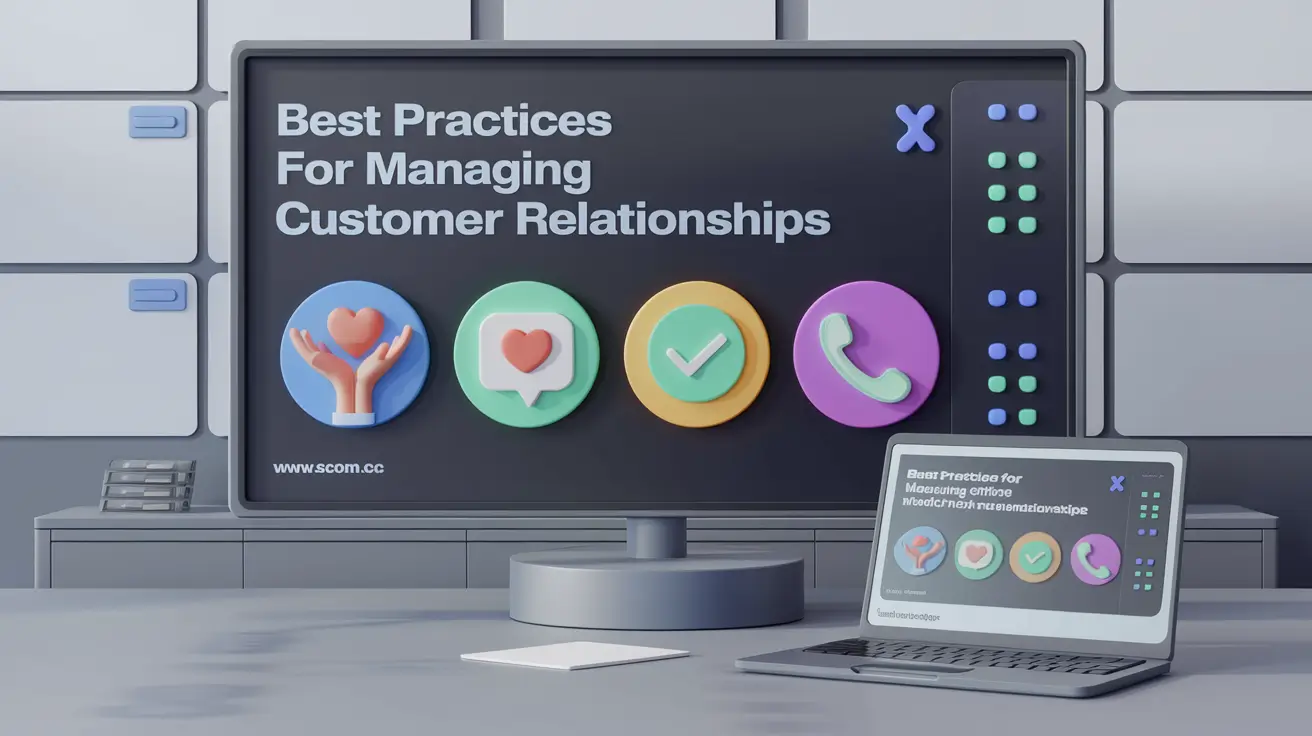Best Practices for Managing Customer Relationships

- Best Practices for Managing Customer Relationships
- Understanding Customer Relationship Management
-
Best Practices for Managing Customer Relationships
- Build a Comprehensive Customer Profile
- Personalize Customer Interactions
- Provide Excellent Customer Service
- Utilize Customer Feedback
- Leverage Technology and Automation
- Develop Customer Loyalty Programs
- 7. Foster Strong Relationships
- Monitor and Measure CRM Performance
- Ensure Data Privacy and Security
- Train and Develop Your Team
- Examples of Successful CRM Implementation
- Summary Table: Best Practices for Managing Customer Relationships
-
FAQ (Best Practices for Managing Customer Relationships)
- What are the benefits of using CRM software?
- How can I personalize customer interactions effectively?
- What should I include in a customer loyalty program?
- How can I ensure data privacy and security?
- What are key performance indicators (KPIs) for CRM?
- How can I collect and use customer feedback?
- How can I train my team for effective CRM?
Best Practices for Managing Customer Relationships
Effective customer relationship management (CRM) is essential for fostering long-term loyalty, enhancing customer satisfaction, and driving business growth. Managing customer relationships involves understanding and addressing customer needs, maintaining clear communication, and using technology to streamline interactions. This guide outlines best practices for managing customer relationships to build strong, lasting connections with your customers.
Understanding Customer Relationship Management
Customer relationship management is a strategy and set of practices designed to manage and improve interactions with current and potential customers. Effective CRM helps businesses understand customer needs, tailor offerings, and enhance the overall customer experience.
The Importance of CRM
Effective CRM is vital for several reasons:
- Customer Retention: Building strong relationships encourages repeat business and reduces churn.
- Customer Satisfaction: Addressing customer needs and concerns improves satisfaction and loyalty.
- Sales Growth: Understanding customer preferences helps in cross-selling and upselling opportunities.
- Competitive Advantage: Strong CRM practices can differentiate your business from competitors.
Key Components of CRM
CRM encompasses various components, including:
- Customer Data Management: Collecting and organizing customer information.
- Communication Management: Handling interactions across various channels.
- Sales Management: Tracking and managing sales activities and opportunities.
- Service Management: Providing support and resolving customer issues.
- Marketing Automation: Automating marketing tasks and campaigns to engage customers effectively.
Best Practices for Managing Customer Relationships
Implementing best practices in CRM helps ensure effective management of customer interactions and enhances overall satisfaction.
Build a Comprehensive Customer Profile
Creating detailed customer profiles enables personalized interactions and targeted marketing efforts.
- Collect Relevant Data: Gather data on customer demographics, purchase history, preferences, and interactions.
- Utilize CRM Software: Use CRM systems to store and manage customer information in a centralized database.
- Update Regularly: Ensure customer profiles are updated with the latest information and interactions.
Personalize Customer Interactions
Personalization enhances the customer experience by making interactions more relevant and engaging.
- Tailor Communications: Use customer data to customize emails, offers, and recommendations based on individual preferences.
- Address by Name: Personalize interactions by using the customer’s name and referencing past interactions.
- Offer Relevant Products: Recommend products or services that align with the customer’s interests and purchase history.
Provide Excellent Customer Service
Exceptional customer service is crucial for maintaining positive relationships and resolving issues effectively.
- Respond Promptly: Address customer inquiries and issues as quickly as possible.
- Offer Multiple Channels: Provide support through various channels, such as phone, email, live chat, and social media.
- Train Staff: Ensure customer service representatives are well-trained and equipped to handle diverse customer needs.
Utilize Customer Feedback
Customer feedback provides valuable insights into areas for improvement and helps enhance the overall experience.
- Solicit Feedback: Use surveys, reviews, and feedback forms to gather customer opinions and suggestions.
- Analyze Feedback: Evaluate feedback to identify common themes, issues, and areas for improvement.
- Act on Insights: Implement changes based on feedback to address concerns and enhance customer satisfaction.
Leverage Technology and Automation
Technology and automation tools streamline CRM processes and improve efficiency.
- CRM Software: Implement CRM systems to manage customer data, track interactions, and automate tasks.
- Marketing Automation: Use tools to automate marketing campaigns, segment audiences, and track engagement.
- Analytics Tools: Utilize analytics to monitor performance, measure customer satisfaction, and identify trends.
Develop Customer Loyalty Programs
Loyalty programs encourage repeat business and reward customers for their continued support.
- Design Reward Programs: Create programs that offer incentives such as discounts, points, or exclusive access to products and services.
- Communicate Benefits: Clearly communicate the benefits of the loyalty program to customers and encourage participation.
- Track Engagement: Monitor participation and engagement with the loyalty program to assess its effectiveness.
7. Foster Strong Relationships
Building strong relationships with customers involves ongoing engagement and support.
- Regular Communication: Maintain regular contact with customers through newsletters, updates, and personalized messages.
- Show Appreciation: Express gratitude for customer loyalty and business through thank-you notes, special offers, or personalized gestures.
- Engage with Customers: Interact with customers on social media, respond to comments, and participate in conversations.
Monitor and Measure CRM Performance
Regularly monitor and measure CRM performance to assess the effectiveness of your strategies.
- Key Performance Indicators (KPIs): Track KPIs such as customer satisfaction scores, retention rates, and response times.
- Customer Metrics: Monitor metrics related to customer engagement, loyalty, and feedback.
- Continuous Improvement: Use performance data to identify areas for improvement and refine CRM strategies.
Ensure Data Privacy and Security
Protecting customer data is essential for maintaining trust and complying with regulations.
- Implement Security Measures: Use encryption, access controls, and secure storage to protect customer data.
- Comply with Regulations: Ensure compliance with data protection regulations such as GDPR and CCPA.
- Communicate Privacy Policies: Clearly communicate your privacy policies and practices to customers.
Train and Develop Your Team
Invest in training and development to ensure your team is equipped to manage customer relationships effectively.
- Ongoing Training: Provide regular training on CRM systems, customer service techniques, and industry best practices.
- Encourage Development: Support professional development opportunities to enhance skills and knowledge.
- Foster a Customer-Centric Culture: Promote a culture focused on customer satisfaction and relationship building.
Examples of Successful CRM Implementation
Amazon’s Customer-Centric Approach
Amazon uses advanced CRM systems to personalize recommendations, streamline order processing, and provide exceptional customer service. The company’s focus on data-driven personalization and efficient service has contributed to its success and customer loyalty.
Starbucks’ Loyalty Program
Starbucks’ loyalty program, Starbucks Rewards, offers customers personalized rewards, discounts, and exclusive offers. The program leverages customer data to provide tailored incentives and enhance the overall experience.
Zappos’ Exceptional Customer Service
Zappos is known for its exceptional customer service and commitment to customer satisfaction. The company empowers its customer service representatives to go above and beyond to resolve issues and create positive experiences.
Summary Table: Best Practices for Managing Customer Relationships
| Best Practice | Description | Benefits | Implementation Tips |
|---|---|---|---|
| Build a Comprehensive Customer Profile | Create detailed profiles using customer data | Enables personalization and targeted marketing | Use CRM software to manage and update profiles |
| Personalize Customer Interactions | Tailor communications and offers based on customer data | Enhances engagement and relevance | Address customers by name and reference past interactions |
| Provide Excellent Customer Service | Offer prompt and effective support through various channels | Improves customer satisfaction and loyalty | Train staff and provide multi-channel support |
| Utilize Customer Feedback | Gather and analyze feedback to identify improvement areas | Provides insights for enhancing the customer experience | Use surveys and reviews to collect feedback |
| Leverage Technology and Automation | Use CRM systems and automation tools to streamline processes | Increases efficiency and accuracy | Implement CRM and marketing automation tools |
| Develop Customer Loyalty Programs | Create programs that reward repeat business | Encourages customer retention and repeat purchases | Design attractive rewards and communicate benefits |
| Foster Strong Relationships | Maintain regular contact and show appreciation | Builds trust and strengthens customer relationships | Engage on social media and express gratitude |
| Monitor and Measure CRM Performance | Track KPIs and customer metrics to evaluate effectiveness | Identifies areas for improvement and success | Regularly review performance data and adjust strategies |
| Ensure Data Privacy and Security | Protect customer data and comply with regulations | Maintains trust and legal compliance | Implement security measures and communicate privacy policies |
| Train and Develop Your Team | Invest in ongoing training and professional development | Enhances skills and supports a customer-centric culture | Provide regular training and development opportunities |
FAQ (Best Practices for Managing Customer Relationships)
What are the benefits of using CRM software?
CRM software helps manage customer data, track interactions, automate tasks, and analyze performance. Benefits include improved customer relationships, increased efficiency, and enhanced decision-making.
How can I personalize customer interactions effectively?
Personalize interactions by using customer data to tailor communications, offers, and recommendations. Address customers by name, reference their past interactions, and offer relevant products or services.
What should I include in a customer loyalty program?
Include rewards such as discounts, points, exclusive access, and personalized offers. Clearly communicate the benefits and ensure the program is easy to join and use.
How can I ensure data privacy and security?
Implement security measures such as encryption, access controls, and secure storage. Comply with data protection regulations and communicate your privacy policies to customers.
What are key performance indicators (KPIs) for CRM?
KPIs for CRM include customer satisfaction scores, retention rates, response times, engagement metrics, and loyalty program participation. Track these metrics to evaluate CRM effectiveness.
How can I collect and use customer feedback?
Collect feedback through surveys, reviews, and feedback forms. Analyze the feedback to identify common themes and areas for improvement, and use the insights to enhance the customer experience.
How can I train my team for effective CRM?
Provide regular training on CRM systems, customer service techniques, and industry best practices. Support professional development and foster a customer-centric culture within your team.

If you enjoyed this article and found it valuable, we encourage you to explore our news and valuable information section, where you'll find more relevant and up-to-date content that may pique your interest. Additionally, if you are seeking advice or need guidance on a specific topic, we suggest visiting our services section. There, you will find a variety of options designed to assist and support you in addressing your needs. Feel free to check out both sections to get the information and assistance that best suits your requirements.

Leave a Reply